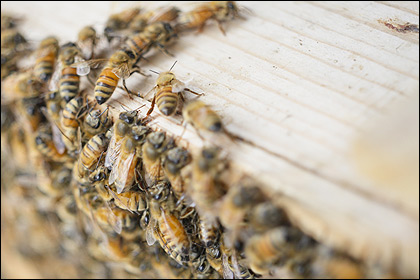Eugene Weekly’s Earth Day Issue:
Carpe the Carp Stalking the elusive *Kentucky tunain Oregon waters
Pretty, Bad Mute swans in Oregonû
Bees, Baby, Baby, Bees Nonnatives make the world go round
Dont Feed the Birds Wild turkeys are really feral
Not So Big, Not So Bad Wolves return to Oregon, cause a ruckus in Congress
Will Work for Food Nonnative earthworms move slow, compost fast
Crawfish, Crawdad, Crayfish Whatever you call them … theyre invading Oregon
Bees, Baby, Baby, Bees
Nonnatives make the world go round
By Shannon Finnell
Four hundred years ago, give or take, a nonnative species came to North America. Stop it. Dont guess white people. Its not that obvious. White people just brought them and their sticky goodness. What were talking about are honeybees.
 |
| Trask Bedortha |
Some of the striped invaders escaped their hives and settled in the wild, but today 99 percent of honeybees live in managed colonies, according to Oregon State University entomologist Ramesh Sagili. Theyve been incorporated into the United States complex system of agriculture; honeybees play an important role in the lives of people, pollinating crops like almonds, avocados, apples and cherries.û
But since the winter of 2006, the honeybee populations that we depend on have dipped drastically across North America, Europe and Asia. Die-offs of honeybees arent unprecedented: In the 1980s, invasive mites reached North America and hammered honeybee hives, and theyre still a problem for beekeepers. Whats different now is that scientists cant identify a singular, specific cause of the bees decline.
Usually we welcome getting rid of a nonnative species. Not so with honeybees. Entomologists started calling the mysterious drop in honeybee populations øColony Collapse Disorder,” or CCD. Sagili says Oregons honeybees are doing better than the national average, with a 26 percent winter death rate in Oregons managed hives compared to 34 percent nationally. But the typical and acceptable winter loss is around ten percent.
While CCD is named as a single disorder, its origin is complex. øWe still think there is no one cause that is responsible for the decline of bees,” Sagili says.û
Pests and pathogens are traditional causes of large-scale bee death, and this continues to be the case with CCD. However, the USDAs CCD steering committee reported in June 2010 that post-collapse hives have provided evidence ofû øan absence of damaging levels of the gut parasite nosema or parasitic varroa mites,” which are the usual bee-killing suspects.
Other pests and pathogens are still likely contributors to CCD, but humans are killing bees, too. Sometimes its hard to avoid ‹ like when beekeepers need to move their hives for the winter due to weather or nutrition needs.
Other human contributions to colony collapse are more difficult for beekeepers to manage because theyre caused by outside factors. Malnutrition from monocultures (big farms that grow one crop) contributes to the problem. øWe have restricted the diet of the honeybee,” Sagili says. øInstead of seven or eight kinds of pollen, there are only two or three.”
Pesticides and fungicides are also killers of these needed nonnative bees; their severity might be increasing because the different chemicals are mixing in what Sagili calls a øcocktail in the hive.” One of the most contentious pesticides is Bayers clothianidin, which is sold under the name øPoncho.” While early evaluations ruled clothianidin safe, more recent accounts are casting doubt. A leaked EPA memo distributed in 2010 stated, øAcute toxicity studies to honey bees show that clothianidin is highly toxic on both a contact and an oral basis.” The National Honey Bee Advisory Board, the American Beekeeping Federation and the American Honey Producers Association all have called for new evaluations of the chemical that could be one of the greatest threats to their livelihoods.
Together, the varied causes of CCD are instigating a multi-continental die-off of honeybees. As the specter of colony collapse disorder hangs over the Pacific Northwest, entomologists are closely watching the rate of winter death. For now, CCD hasnt caused enough of a die-off to threaten the crops, but how will thoseû crops survive if honeybees cant do the job?
øThe bees that we have here cannot replace honeybees,” says OSU entomologist Sujaya Rao, who studies native pollinators. It isnt that native bees are nectar snobs who hate orchard trees. Rather, honeybees live in much larger swarms than native bees. øThe numbers are good but not as high,” Rao says of the native bees.
Sagili says that even though most bees live in managed hives, øThere are small things that everyone can do.” Adding plants like foxglove or lavenderû to your garden provides both honeybees and native pollinators with a continuous, diverse supply of nectar and pollen. And if youre looking for a challenging project, backyard beekeeping is as tough as ever.û